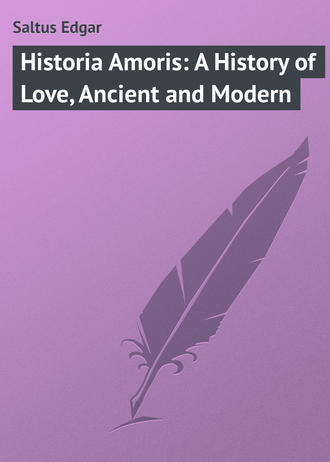 полная версия
полная версияHistoria Amoris: A History of Love, Ancient and Modern
But Radegonde was not Lesbia, and Fortunatus, though a poet, confined his licence to verse. Together they collaborated in the first romance of pure sentiment that history records, one from which the abbess passed to sanctity, and the poet to fame. Thereafter the story persisting may have suggested some one of the pedestals that antiquity never learned to sculpture and to which ladies were lifted by their knights.
Meanwhile love had assumed another shape. Radegonde, before becoming an abbess, had been a queen. As a consequence she had prerogatives which other women lacked. It was not every one that could entertain a tarrying minstrel. It was not every one that would. The nun generally was emancipated from man as thoroughly as the hetaira had been from marriage. But the latter in renouncing matrimony did not for that reason renounce love and there were many cloistered girls who, in renouncing man, did not renounce love either. One of them dreamed that on a journey to the fountain of living waters, a form appeared that pointed at a brilliant basin, to which, as she stooped, Radegonde approached and put about her a cloak that, she said, was sent by the girl’s betrothed.
Radegonde was then dead and a saint. The dream of her, particularly the gift, more especially its provenance, seemed so ineffable that the girl could think of nothing else save only that when at last the betrothed did come, the nuptial chamber should be ready. She begged therefore that there be given her a little narrow cell, a narrow little tomb, to which, the request granted, other nuns led her. At the threshold she kissed each of them, then she entered; the opening was walled and within, with her mystic spouse, the bride of Christ remained.33
At Alexandria, something similar had already occurred. There another Hypathia, fair as she, refused Christianity, refused also marriage. God did not appeal to her, man did not either. But a priest succeeded in interesting her in the possibility of obtaining a husband superior to every mortal being on condition only that she prayed to Mary. The girl did pray. During the prayer she fell asleep. Then beautiful beyond all beauty the Lord appeared to whom the Virgin offered the girl. The Christ refused. She was fair but not fair enough. At that she awoke. Immortally lovely and mortally sad she suffered the priest to baptize her. Another prayer followed by another sleep ensued in which she beheld again the Christ who then consenting to take her, put on her finger a ring which she found on awakening.
The legend, which afterward inspired Veronese and Correggio, had a counterpart in that of St. Catherine of Sienna. To her also the Christ gave a ring, yet one which, Della Fonte, her biographer, declared, was visible only to herself. The legend had also a pendant in the story of St. Theresa, a Spanish mystic, who in her trances discovered that the punishment of the damned is an inability to love. In the Relacion de su vida the saint expressed herself as follows:
“It seemed to me as though I could see my soul, clearly, like a mirror, and that in the centre of it the Lord came. It seemed to me that in every part of my soul I saw him as I saw him in the mirror and that mirror, I cannot say how, was wholly absorbed by the Lord, indescribably, in a sort of amorous confusion.”
The mirror was the imagination, the usual reflector of the beatific. It was that perhaps to which Paul referred when he said that we see through a glass darkly. But it was certainly that which enabled Gerson to catalogue the various degrees of ravishment of which the highest, ecstasy, culminates in union with Christ, where the soul attaining perfection is freed.
Gerson came later but theories similar to his, which neoplatonism had advanced, were common. In that day or more exactly in that night, the silver petals of the lily of purity were plucked so continuously by so many hands, so many were the eyes strained on the mirror, so frequent were the brides of Christ, that the aberration became as disquieting as asceticism. Then through fear that woman might lose herself in dreams of spiritual love and evaporate completely, an effort was attempted which succeeded presently in deflecting her aspirations to the Virgin who, hitherto, had remained strictly within the limits originally traced. Commiserate to the erring she was Regina angelorum, the angel queen. In the twelfth century suddenly she mounted. From queen she became sovereign. Ceremonies, churches, cathedrals, were consecrated uniquely to her. In pomp and importance her worship exceeded that of God. When Satan had the sinner in his grasp, it was she who in the prodigalities of her divine compassion rescued and redeemed him.34
In the art of the period, such as it was, the worship was reflected. The thin hands of saints, the poignant eyes of sinners, were raised to her equally. The fainting figures that were painted in the ex-voto of the triptiques seemed ill with love. The forms of women, lost beneath the draperies, disclosed, if anything, emaciation. The expression of the face alone indicated what they represented and that always was adoration. They too were swooning at the Virgin’s feet.
Previously Paul had been studied. It was seen that a thorn had been given him, a messenger of Satan, from which, three times he had prayed release. But the Lord said to him: “My grace is sufficient to thee, for my strength is made perfect in weakness.” “Wherefore,” said Paul, “most gladly will I glory in my infirmities.”35
Precisely what the apostle meant is immaterial. But from his words the inference was drawn that in weakness is salvation and in sin the glory of God.
The early Church had not interpreted the evangels with entire correctness. It is possible that in the Græco-Syrian dialect which the apostles employed, their meaning was sometimes obscure. It is presumable for instance that the coming of the Kingdom of God which they proclaimed was not the material termination of a material world but the real Kingdom which did really come in the hearts of those that believed. “Comprends, pécheur,” Bossuet thundered at a later day, “que tu portes ton paradis et ton enfer en toi-même.” The patricists were not Bossuets. They were literal folk. They stuck to the letter. Having discovered what they regarded as a divine command for abstinence, asceticism in all its rigors ensued. Subsequent exegetes finding in Paul a few words not over precise, discovered in them a commendation of sin as a means of grace. The discovery, amplified later by Molinos, had results that made man even less attractive than he had been.
Meanwhile, between insanity and disorder, woman, indifferent as always to texts, had found a form of love which, however impossible, was one that in its innocence obscured the stupidities and turpitudes of the day. Then, after the substitution of the Rosa mystica for the mystic lily, tentatively there began an affranchisement of communes, of women and of thought.
Hitherto it had been blasphemy to think. The first human voice that the Middle Ages heard, the first, voice distinguishable from that of kings, of felons and of beasts, was Abailard’s. Whatever previously had been said was bellowed or stuttered. It was with the forgotten elegance of Athens that Abailard spoke, preaching as he did so the indulgence of God, the rehabilitation of the flesh, the inferiority of fear, love’s superiority.
Abailard, fascinating and gifted, was familiar with Greek and Hebrew, attainments then prodigious to which he added other abilities, the art of calming men while disturbing women – among others a young Parisian, Héloïse, herself a miracle of erudition and of beauty.
Abailard at the time was nearly thirty-eight, Héloïse not quite eighteen. Between them a liaison ensued that resulted in a secret marriage which Abailard afterward disavowed and which, for his sake, Héloïse denied. It ruined their lives and founded their fame. Had it been less catastrophic no word or memory of them could have endured. Misfortune made immortal these lovers, one of whom took the veil and the other the cowl and whose story has survived that of kingdoms.
In separation they corresponded. The letters of Héloïse are vibrant still. Only Sappho, in her lost songs to Phaon, could have exceeded their fervor. “God knows,” she wrote, “in you I sought but you, nothing but you. You were my one and only object, marriage I did not seek, nor my way but yours uniquely. If the title of wife be holy, I thought the name of mistress more dear. Rather would I have been called that by you than empress by an emperor.”
Abailard’s frigid and methodical answers were headed “To the bride of Christ,” or else “To my sister in Christ, from Abailard, her brother.” The tone of Héloïse’s replies was very different. “To my master, no; to my brother, no; to my husband, no; his sister, his bride, no; from Héloïse to Abailard.” Again she wrote: “At every angle of life God knows I fear to offend you more than Him, I desire to please Him less than I do you. It was your will not His that brought me where I am.”
It was true. She took the veil as though it were poison. She broke into the priory violently as the despairful plunge into death. Even that could not assuage her. But in the burning words which she tore from her breaking heart the true passion of love, which nothing earthly or divine can still, for the first time pulsated.
II
THE PURSUIVANTS OF LOVE
There is no immaculate history. If there were it would relate to a better world. Unable to be immaculate, history usually is stupid, more often false. Concerning the Middle Ages it has contrived to be absurd. It attributed the recovery of light to the Tiers état. Darkness was dispersed by love, whose gereralissimi were the troubadour and the knight. Concerning the latter history erred again. Tacitus aiding, it derived chivalry from Germany. Chivalry originated in the courts of the emirs. The knight and the troubadour came from Islâm. Together they resummoned civilization.
The world at the time was divided. Long since Europe and Asia had gone their separate ways. When at last they caught sight of each other, the Church sickened with horror. There ensued the Crusades in which the Papacy pitted Christianity against Muhammadanism and staked the authenticity of each in the result. The result was that Muhammadanism proved its claim. On the way to it was Byzance.
Beside the bleak burgs, squalid ignorance and abysmal barbarism of Europe, Byzance isolated and fastidious, luxurious and aloof, learned and subtle, Roman in body but Greek in soul, contrasted almost supernaturally. Set apart from and beyond the mediæval night, her marble basilicas, her golden domes, her pineapple cupolas covered with colors, her ceaseless and gorgeous ceremonials, gave her the mysterious beauty of a city shimmering on uplands of dream. It was a dream, the final flower of Hellenic art. The people, delicately nurtured on delicate fare, exquisitely dressed in painted clothes, rather tigerish at heart but exceedingly punctilious, equally contemptuous and very well bred, must have contrasted too with the Crusaders.
Contiguous was Persia which, taken by Muhammad, had, with but the magic wand of her own beauty, transformed his trampling hordes into a superb and romantic nation, fanatic indeed, quick with the scimitar, born fighters who had passed thence into Egypt, Andalusia, Syria, Assyria and beyond to the Indus. The diverse lands they had subjugated and united into one vast empire. Baghdad was their caliphate.
Before the latter and on through the Orient were strewn in profusion the marvellous cities of the Thousand and One Nights, the enameled houses of the Thousand and One Days. There, in courtyards curtained with cashmeres, chimeras and hippogriffs crouched. The turbans of the merchants that passed were heavy with sequins and secrets. The pale mouths of the blue-bellied fish that rose from the sleeping waters were aglow with gems. In the air was the odor of spices, the scent of the wines of Shiraz. Occasionally was the spectacle of a faithless favorite sewn in a sack and tossed by hurrying eunuchs into the indifferent sea.
The sight was rare. The charm of Scheherazade and Chain-of-Hearts prevailed. The Muslim might dissever heads as carelessly as he plucked an orange, they were those of unbelievers, not of girls. Among the peris of his earthly paradise he was passionate and gallant. It is generally in this aspect that he appears in the Thousand and One Nights, which, like the Thousand and One Days, originally Persian in design, had been done over into arabesques that, while intertwisting fable and fact, none the less displayed the manners of a nation. Some of the stories are as knightly as romaunts, others as delicate as lays; all were the unconsidered trifles of a people who, when the Saxons were living in huts, had developed the most poetic civilization the world has known, a social order which, with religion and might for basis, had a superstructure of art and of love.
It was this that louts in rusty mail went forth to destroy. But though they could not conquer Islâm, the chivalry of the Muslim taught them how to conquer themselves. From the victory contemporaneous civilization proceeds.
With the louts were women. An army of Amazons set out for the Cross where they found liberty, new horizons, larger life, and, in contact with the most gallant race on earth, found also theories of love unimagined. In the second crusade Eleanor, then Queen of France, afterward Queen of England, alternated between clashes and amours with emirs. The example of a lady so exalted set a fashion which would have been adopted any way, so irresistible were the Saracens.36
It was therefore first in Byzance and then in Islâm that the Normans and Anglo-Normans who in the initial crusade went forth to fight went literally to school. They had gone on to sweep from existence inept bands of pecculant Bedouins and discovered that the ineptity was wholly their own. They had thought that there might be a few pretty women in the way, only to find their own women falling in love with the foe. They had thought Tours and Poictiers were to be repeated.
It was in those battles that Europe first encountered Islâm. Had not the defeat of the latter resulted, the world might have become Muhammadan, or, as Gibbon declared, Oxford might to-day be expounding the Koran. But though the Moors, who otherwise would have been masters of Europe, retreated, it is possible that they left a manual of chivalry behind. Even had the attention been overlooked, already from Andalusia the code was filtering up through Provence. Devised by a people who of all others have been most chivalrous in their worship of women it surprised and then appealed. Adopted by the Church, it became the sacrament of the preux chevalier who swore that everywhere and always he would be the champion of women, of justice and of right.
The oath was taken at an hour when justice was not even in the dictionaries – there were none – at an epoch when every man who was not marauding was maimed or a monk. At that hour, the blackest of all, there was proposed to the crapulous barons an ideal. Thereafter, little by little, in lieu of the boor came the knight, occasionally the paladin of whom Roland was the type.
Roland, a legend says, died of love before a cloister of nuns. Roland himself was legendary. But in the Chanson de Roland which is the right legend, he died embracing his sole mistress, his sword. Afterward a girl asked concerning him of Charlemagne, saying that she was to be his wife. The emperor, after telling of his death, offered the girl his son. The girl refused. She declined even to survive. In the story of Roland that is the one occasion in which love appeared. It but came and vanished with a hero whose name history has mentioned but once and then only in a monkish screed,37 yet whose prowess romance ceaselessly celebrated, inverting chronology in his behalf, enlarging for his grandiose figure the limits of time and space, lifting his epic memories to the skies.
What Jason had been in mythology, Roland became in legend, the first Occidental custodian of chivalry’s golden fleece, which, he gone, was found reducible to just four words – Death rather than dishonor.
Dishonor meant to be last in the field and first in the retreat. Honor meant courage and courtesy, the reverencing of all women for the love of one. It meant bravery and good manners. It meant something else. To be first in the field and last in the retreat was necessary not merely for valor’s sake, but because courage was the surest token to a lady’s favor, which favor fidelity could alone retain. Hitherto men had been bold, chivalry made them true. It made them constant for constancy’s sake, because inconstancy meant forfeiture of honor and any forfeiture degradation.
When that occurred the spurs of the knight were hacked from his heels, a ceremony overwhelming in the simplicity with which it proclaimed him unfit to ride and therefore for chivalry.
Yet though a man might not be false to any one, to some one he must be true. If he knew how to break a lance but not how to win a lady he was less a knight than a churl. “A knight,” said Sir Tristram, “can never be of prowess unless he be a lover.” “Why,” said the belle Isaud to Sir Dinadan, “are you a knight and not a lover? You cannot be a goodly knight except you are?” “Jesu merci,” Sir Dinadan replied. “Pleasure of love lasts but a moment, pain of love endures alway.”
Sir Dinadan was right, but so was Sir Tristram, so was the belle Isaud. A knight had to be brave, he had to be loyal and courteous in war, as in peace. But he had to be also a lover and as a lover he had to be true.
“L’ordre demande nette vieChasteté et curtesye.”The demand was new to the world. Intertwisting with the silver thread which chivalry drew in and in throughout the Middle Ages, it became the basis of whatever is noble in love to-day. The sheen of that thread, otherwise dazzling, shines still in Froissart and in Monstrelet, as it must have shone in the tournaments, where, in glittering mail, men dashed in the lists while the air was rent with women’s names and, at each achievement, the heralds shouted “Loyauté aux Dames,” who, in their tapestried galleries, were judges of the jousts.
Dazzling there it must have been entrancing in the halls and courts of the great keeps where knights and ladies, pages and girls, going up and down, talked but of arms and amours, or at table sat together, two by two, in hundreds, with one trencher to each couple, feasting to the high flourishes of trumpets and later knelt while she who for the occasion had been chosen Royne de la Beaulté et des Amours, awarded the prizes of the tourney, falcons, girdles or girls.
Life then was sufficiently stirring. But the feudal system was not devised for the purposes of love, and matrimony, while not inherently prejudicial to them, omitted, as an institution, to consider love at all. Love was not regarded as compatible with marriage and a lady married to one man was openly adored by another, whom she honored at least with her colors, which he wore quite as openly in war and in war’s splendid image which the tournament was.
In circumstances such as these and in spite of ideals and injunctions, it becomes obvious if only from the Chansons de geste, which are replete with lovers’ inconstancies, that the hacking of spurs could not have continued except at the expense of the entire caste. The ceremony was one that hardly survived the early investitures of the men-at-arms of God. It was too significant in beauty.
The fault lay not with chivalry but with the thousand-floored prison that feudalism was. In it a lady’s affections were administered for her. Marriage she might not conclude as she liked. If she were an heiress it was arranged not in accordance with her choice but her suzerain’s wishes and in no circumstances could it be contracted without his consent. Under the feudal system land was held subject to military service and in the event of the passing of a fief to a girl, the overlord, whose chief concern was the number of his retainers, could not, should war occur, look to her for aid. The result being that whatever vassal he thought could serve him best, he promptly gratified with the land and the lady, who of the two counted least.38
The proceeding, if summary, was not necessarily disagreeable. Girls whose accomplishments were limited to the singing of a lai or the longer romaunt and who perhaps could also strum a harp, were less fastidious than they have since become. Advanced they may have been in manners but in delicacy they were not. Their conversation as reported in the fabliaux and novelle was disquietingly frank. When, as occasionally occurred, the overlord omitted to provide a husband, not infrequently they demanded that he should. As with girls, so with widows. Usually they were remarried at once to men who had lost the right to kill them but who might beat them reasonably in accordance with the law.39
The law was that of the Church who, in authorizing a reasonable beating, may have had in view the lady’s age, which sometimes was tender. Legally a girl could not be married until she was twelve. But feudalism had evasions which the Church could not always prevent. Sovereign though she were over villeins and vassals and suzerains as well, yet the high lords, sovereign too, married when and whom they liked, children if it suited them and there was a fief to be obtained.
They married the more frequently in that marriage was easily annulled. Even the primitive Church permitted divorce. “Fabiola,” said a saint, “divorced her husband because he was vicious and married again.”40 In the later Church matrimony was prohibited within the seventh degree of consanguinity in which the nominal relationship of godfather and godmother counted equally with ties of blood and created artificial sets of brothers, sisters, cousins and remoter relatives, all of whom stood within the prohibited degrees. Relationship of some kind it was therefore possible to discover and also to invent, or, that failing, there was yet another way. A condition precedent to matrimony was the consent, actual or assumed, of the contracting parties. But as in the upper classes it was customary to betroth children still in the cradle, absence of consent could readily be alleged. As a consequence any husband that wished to be off with the old wife in order to be on with the new, might, failing relationship on his part, advance absence of consent on hers, the result being that the chivalric injunction to honor all women for the love of one, continued to be observed since one was so easily multiplied.41
Thereafter began the subsidence of the order which at the time represented what heroism had in the past, with the difference, however, that chivalry lifted sentiment to heights which antiquity never attained. The heights were perhaps themselves too high. On them was the exaltation of whatever is lofty – honor, courage, courtesy and love. It was the exaltation of love that made Don Quixote station himself in the high road and prevent the merchants from passing until they acknowledged that in all the universe there was no one so beautiful as the peerless Dulcinea del Toboso. But it was the exaltation of humor that made him answer a natural inquiry of the merchants in regard to the lady by exclaiming: “Had I shown her to you what wonder would it be to acknowledge so notorious a truth? The importance of the thing lies in compelling you to believe it, confess it, swear it, and maintain it without seeing her at all.”
Exaltation lifted to a pitch so high could but squeak. The world laughed. Chivalry outfaced by ridicule succumbed. It had become but a great piece of empty armor that needed but a shove to topple. In the levelling democracy of fire-arms it fell, pierced by the first bullet, yet surviving itself in the elements of which the gentleman is made and in whatever in love is noble.
III
THE PARLIAMENTS OF JOY
The decalogue of the Zend-Avesta mentions many strange sins. The strangest among them is sorrow. The Persian abhorred it. His Muhammadan victor, who had learned from him much, learned also its avoidance. If it ever perturbed the Moors, by the time Andalusia was theirs it had vanished. Joy was a creed with them. Their poets made it the cardinal virtue. The Aragonese and Provençals, whom they indoctrinated, made it the basis of the gaya cienca– the gay science of love, and chivalry the parure of the knight.











